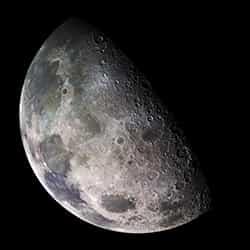Moon Mythology
People from all over the world have stories that explain the Moon's path across the sky. According to a myth of the Maori people of New Zealand, the Moon slipped behind the clouds one night when Rona, the daughter of the sea god, was carrying a bucket of water back home to her children. Unable to see, she tripped on a root and cursed the Moon. The Moon was insulted and took Rona up to the sky. The Maori say that floods and tides occur when Rona upsets her bucket. The Inuit people of the Arctic explain the phases of the Moon with a story about the Moon god Anningan, who continually chases his sister, the Sun goddess, across the sky. He forgets to eat, grows thin, disappears to eat for three days, and returns as a full Moon to start chasing her again.
Diameter: 2,200 miles
Average Distance from the Earth: 240,000 miles
Average Surface Temperature: -4 degrees F
Orbital Period: 29.5 days
First human landing: July 20, 1969
Characteristics: rocky surface is covered with light-colored highlands, mountains, and darker, lava-filled craters
Significance: Earth's only natural satellite

The Moon shines because:
sunlight is reflected by the Moon's surface
small explosions erupt from its many volcanoes
Moon dust glows in the dark
Correct!
The Moon cannot take all of the credit for being the brightest object in the night sky. The Moon shines only because light from the Sun reflects off its surface.
The Moon's gravity affects the Earth.
Fact
The Moon's gravitational pull causes tides in Earth's oceans and other large bodies of water.
Rocks brought back from Apollo astronauts provided clues to the Moon's birth. It is made up of material thrown into orbit when a planet slammed into Earth during the formation of the planets.

Mordecai-Mark MacLow, astrophysicist




 Biodiversity
Biodiversity
 Brain
Brain
 Genetics
Genetics
 Marine BiOLogy
Marine BiOLogy
 MicrobiOLogy
MicrobiOLogy
 PaleontOLogy
PaleontOLogy
 ZoOLogy
ZoOLogy
 AnthropOLogy
AnthropOLogy
 ArchaeOLogy
ArchaeOLogy
 Astronomy
Astronomy
 Climate Change
Climate Change
 Earth
Earth
 Physics
Physics
 Water
Water
